
Did you know that In the coldest regions, winter creates a phenomenon known as ‘diamond dust’: tiny ice crystals suspended in the air, glittering like a thousand diamonds in the sunlight, turning the landscape into a sparkling wonderland?
This natural spectacle, known as ‘diamond dust,’ is just one example of the captivating wonders winter holds. Children can make the most of this season by engaging in STEM (Science, Technology, Engineering, and Mathematics) challenges and winter science experiments to understand and appreciate the intricate workings of the world.
These hands-on experiences become the cornerstone of a child’s educational journey, igniting their curiosity and setting them on a path toward a future of innovation and discovery.
Recommended Reading: WHAT IS STEM EDUCATION? A GUIDE FOR PARENTS
Why Are STEM Challenges And Winter Science Experiments Important?
STEM challenges and winter science experiments are crucial for children as they provide hands-on learning experiences while stimulating critical thinking, problem-solving skills, and curiosity. It helps in bridging the gap between theoretical knowledge and practical application, preparing children for future careers in science, technology, engineering, and mathematics. Additionally, these activities make learning enjoyable, fostering a lifelong love for exploration and discovery.
Moonprenuer here has curated the list of some interesting and fun STEM Challenges and Winter Science Experiments.
1. Pasta Bridge Challenge
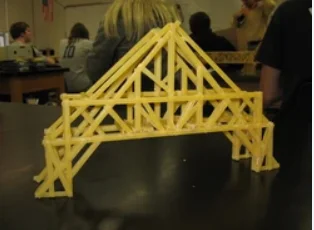
A well-liked STEM project is the Pasta Bridge Challenge. In this project, children have to create a bridge using different pasta and an appropriate glue (typically hot glue or white glue).
The main objective of the project is to design and build a bridge using only pasta and glue that can support a predetermined weight without breaking or collapsing.
The rules and regulations, that are to be kept in mind are:
- Participants are allowed to use whatever combination of glue and pasta varieties.
- Pasta and glue should be used alone to construct the bridge; no other materials are permitted.
- It cannot be attached to or supported by any external structures; the bridge must be freestanding.
- Participants should indicate the kind and location of weights to be added to the bridge before testing.
The bridge can be tested after the adhesive has dried. The bridge is steadily loaded until it collapses or achieves its maximum load-bearing capability.
Recommended Reading: TOP 10 STEM SKILLS FOR KIDS IN 2023
2. Igloo Engineering
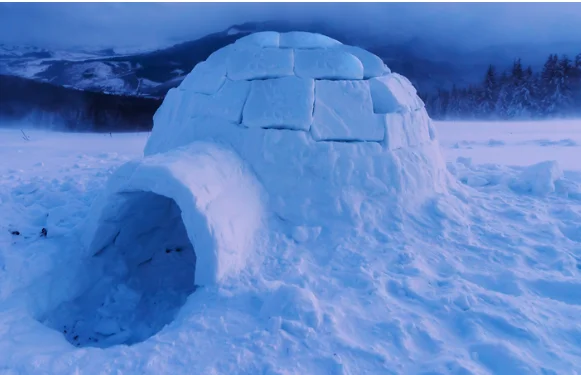
Image Source: https://wardsworld.wardsci.com/
Igloo Engineering is an interesting STEM project. Participants construct a tiny igloo out of various materials.
The primary purpose is to design and build a miniature igloo using ingredients such as marshmallows, sugar cubes, or other little blocks, as well as an appropriate adhesive such as icing or glue.
The Igloo Engineering project is subject to the following rules and guidelines:
- Participants are free to choose and combine various materials to construct their igloo.
- The igloo’s construction should be limited to the materials chosen; no exterior supports or additional materials are permitted.
- The igloo must be self-supporting and free-standing, with no attachments or external support.
- Participants must define the type and placement of weights to be added to the igloo prior to testing.
Testing occurs once the adhesive has dried and the igloo is complete. The igloo’s structural integrity is examined by progressively increasing pressure or weight until it collapses or exhibits its maximum load-bearing capabilities.
Participants in Igloo Engineering are challenged to investigate architectural concepts and construction processes while building small igloos.
Recommended Reading: 5 DIY STEM KITS FOR KIDS
3. Snowball Science

Image Source: https://blog.pitsco.com/
Snowball Science investigates how numerous elements influence snowball development and behavior. It’s a fascinating method for kids to interact with snow’s physical qualities while learning about the scientific principles involved.
Material Required
- Snow (ideally freshly fallen, fluffy snow)
- Thermometer (for determining temperature)
- Mittens or gloves (to keep hands warm)
- Stopwatch or timer (for data collection)
- Snow kinds (if accessible, e.g., wet snow, powdery snow)
Procedure
- Choose a Location: Find a location with enough clean snow for the experiment. Make sure it’s free of garbage and strange things.
- Temperature Measurement: Using the thermometer, determine the temperature of the snow and the surrounding surroundings. Take this as your starting temperature.
- Gather Snow: Gather enough snow to make multiple snowballs. Firmly pack the snow to produce regular, round snowballs. Each one should be the same size and form.
Experiment 1: The Influence of Temperature
Make two snowballs out of the snow from the same location. Hold a snowball in your hands for a few minutes to gradually reheat it. Allow the second snowball to remain at its original temperature.
Observe any differences in packing and tossing after warming one snowball against the unwarmed snowball.
Experiment 2: Influence of Snow Type
Make snowballs with each sort of snow available (for example, moist snow and powdery snow).
Compare how easy or challenging it is to pack and toss different textures of snowballs.
Keep a journal of your observations:
Keep the following in mind:
- How easy does the snow compact into a snowball?
- How well does the snowball keep its shape while being packed and thrown?
- How far does each snowball go when launched with equal force?
This experiment teaches youngsters about how temperature and snow type affect snow characteristics and snowball behavior. It also teaches concepts such as matter states and the impact of temperature on materials.
4. Frozen Bubbles
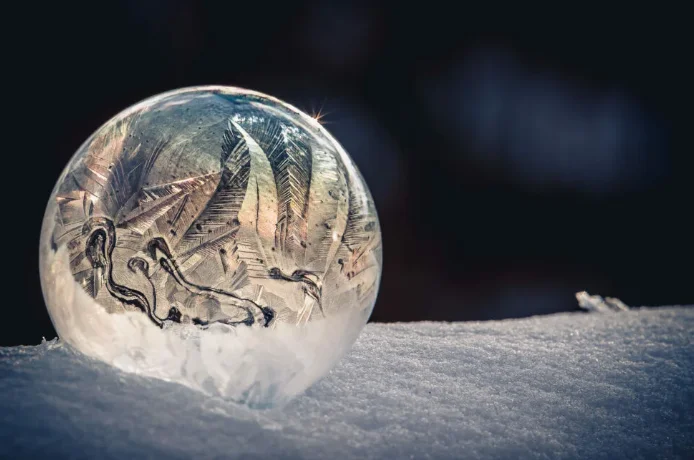
Image Source: https://www.popsci.com/
Frozen Bubbles is an enthralling winter science experiment that includes blowing soap bubbles in cold conditions and watching them freeze and form exquisite ice patterns. It’s a fantastic approach to mix the science of freezing with the enchantment of winter.
Material Required
- Bubble solution (store-bought or homemade with water, dish soap, and glycerin)
- To blow bubbles, use a bubble wand or a straw.
- Freezing temperatures (below 32°F or 0°C) in an outdoor location
- A piece of black paper or fabric to place behind the bubbles for improved visibility is optional.
Procedure
- Make the Bubble Solution: Pour the store-bought solution into a container. In a basin, combine water, dish soap, and a tiny bit of glycerin if making your own.
- Select an Appropriate Location: Make sure you’re in an outdoor area with temperatures below freezing. On a frigid winter day, this could be in your backyard or a park.
- Blow Bubbles: Create bubbles by dipping the bubble wand or straw into the bubble solution and gently blowing bubbles. Make sure the bubbles are large enough to be seen.
- Examine the Freezing Process: You’ll see that the bubbles begin to freeze as they float in the cold air. Keep an eye out for the transition from liquid to solid as ice crystals grow on the surface.
- Examine Ice Patterns: Keep an eye out for the beautiful patterns that form on the surface of the frozen bubbles. The arrangement of ice crystals creates these patterns.
Observations:
- As the bubbles freeze, they will change from their original spherical shape to more irregular ones.
- On the surface of the bubbles, delicate ice crystals will grow, producing stunning patterns.
- The frozen bubbles will gradually collapse and shatter, leaving behind frozen soap film residues.
The experiment Frozen Bubbles is a visually appealing display of the physics of freezing. It depicts the transition from a liquid (soap bubble) to a solid (ice) state and allows the viewer to observe exquisite ice crystal forms. It’s a fun and memorable method to learn about how freezing temperatures affect matter.
Recommended Reading: BEST 12 ROBLOX CHALLENGES FOR KIDS
5. Snow Volcano
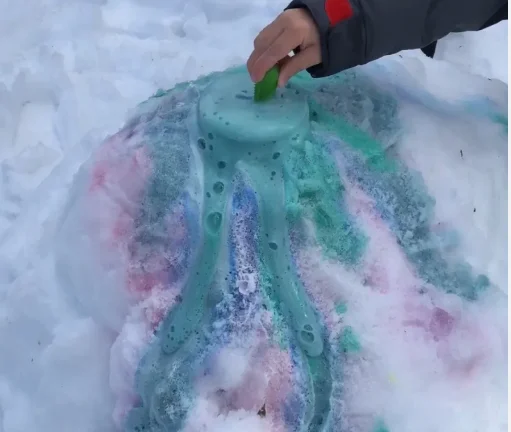
Image Source: https://www.raisingdragons.com/
A Snow Volcano is a delightful project that blends the enchantment of snow with a fizzy chemical reaction. This project makes a small volcano out of the snow as the “mountain” and a simple mixture of household goods to simulate a volcanic eruption.
Material Required
- (enough snow to form a tiny mountain)
- Baking powder
- Dish detergent
- Vinegar
- Optional red food coloring (for visual effect)
- Container (to hold the baking soda mixture) or plastic bottle
Procedure
- Create a Snow Mountain: Build a snow pile in the shape of a volcano. This will function as your experiment’s mountain.
- Make the Baking Soda Concoction: Combine a few tablespoons of baking soda and a tiny amount of dish soap in a container or plastic bottle. This is the “lava” that will explode from the volcano.
- Pour in the Baking Soda Mixture: If you’re using a container, place it at the peak of the snow mountain. Invert a plastic bottle and place it in the snow, leaving the neck exposed. This will be the volcano’s “vent.”
- Add Red Food Coloring if desired: Add a few drops of red food coloring to the baking soda mixture to create the appearance of molten lava.
- Time of Eruption: Pour a generous amount of vinegar into the container or bottle when you’re ready for the eruption. This reacts with the baking soda, resulting in a foamy eruption.
Observations
As the vinegar mixes with the baking soda, you’ll notice a bubbly reaction. This is a classic acid-base interaction that produces carbon dioxide gas, resulting in a frothy eruption.
The Snow Volcano experiment is a visually appealing and entertaining approach to learning about chemical processes. It depicts the reaction of an acid (vinegar) and a base (baking soda), which results in the production of carbon dioxide gas. The snowy landscape serves as an interesting backdrop for the “eruption,” making it an enjoyable and educational winter pastime.
6. Winter Bird Feeder
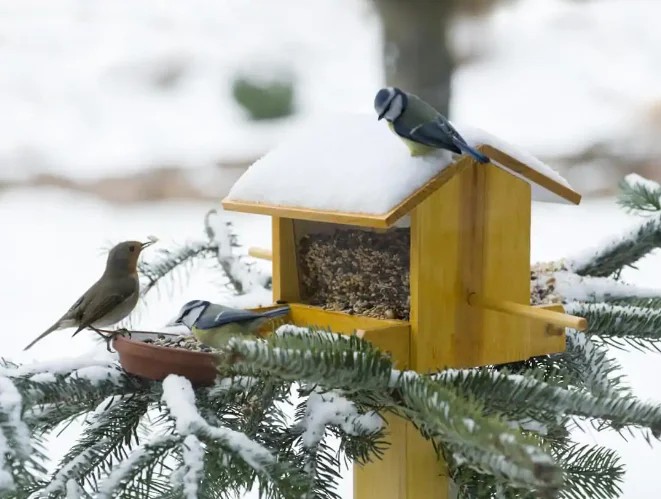
Winter Bird Feeder is a fun activity that allows children to watch and interact with local bird species over the winter. It entails setting up a feeding station where birds may quickly obtain food, allowing them to live and grow during the winter.
Material Required
- Pinecones
- If allergies are an issue, use suet instead of peanut butter.
- Birdseed mixture (a mixture of seeds such as sunflower, millet, and cracked corn)
- Twine or string
- Bird feeder hooks or branches to hang the feeders are optional.
Procedure
- Gather Pinecones: Go outside and collect some pinecones. Look for ones with open scales and spaces between them.
- Hanging String Tie: Tie a piece of string or twine tightly around the top of each pinecone. Leave a length of twine to hang it with.
- Spread over peanut butter or suet: Apply a layer of peanut butter (or suet, if using) on the pinecone scales. Make sure it gets into the cracks.
- Sprinkle with Birdseed: Roll the peanut butter-covered pinecone lightly in a bowl of birdseed to help the seeds stick.
- Suspend the Feeder: Locate an appropriate area to hang the bird feeder. This might be done on a tree branch, a hook, or a bird feeder pole. Make sure it’s high enough to prevent predators while yet being accessible to birds.
- Bird Observation and Identification: Once the feeder is in place, keep an eye on the birds that come to visit. To identify the different species, use a bird handbook or an app.
Observation
Keep an eye out for the many species of birds that come to the feeder. Feeding habits and preferences may differ between animals.
Making a Winter Bird Feeder is a great way to connect with nature, especially during the colder months when food supplies for birds can be limited. It teaches children about local bird species and their eating habits and allows them to go birdwatching right in their backyard. It also instills a sense of responsibility in the care of wildlife.
Conclusion
Being involved in STEM challenges and winter scientific activities introduces youngsters to a realm of discovery, creativity, and critical thinking. These hands-on activities not only make learning fun but also establish vital skills that will last far beyond the winter season. From building snow volcanoes to understanding the mysteries of frozen bubbles, each experiment piques one’s interest and fosters a passion of scientific inquiry.
Furthermore, the teamwork and problem-solving skills that these challenges foster prepare young brains for a future in which STEM expertise is increasingly important. Let us grab the chance to inspire tomorrow’s scientists, engineers, and innovators via the wonder of winter science as the snowflakes fall and the temperatures drop.
Moonpreneur is on a mission to disrupt traditional education and future-proof the next generation with holistic learning solutions. Its Innovator Program is building tomorrow’s workforce by training students in AI/ML, Robotics, Coding, IoT, and Apps, enabling entrepreneurship through experiential learning.

























